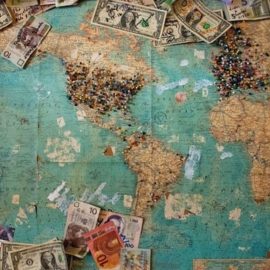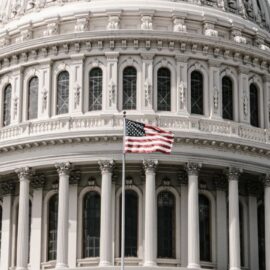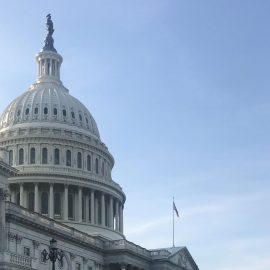

This article is an excerpt from the Shortform book guide to "How to Avoid a Climate Disaster" by Bill Gates. Shortform has the world's best summaries and analyses of books you should be reading.
Like this article? Sign up for a free trial here.
What role should the government play in addressing climate change? What are the major challenges national governments face in curbing carbon emissions?
The most meaningful climate change interventions should come from national governments. Only the highest levels of government can create and enforce the large-scale policies needed to achieve significant carbon reduction quickly.
According to Bill Gates, enacting change at the highest levels of government is challenging for four reasons.
1. Entrenched Systems
Our current systems are set up for fossil fuels. A switch to carbon-less energy would necessitate modifications at every level of government, from international trade agreements and economic policies to physical infrastructure (including a new national power grid) and building codes, down to outfitting individual homes for renewable energy sources.
(Shortform note: As Gates explains, fossil fuels have been the default energy system in many highly developed economies for decades. However, the Biden administration has taken steps to dissuade other nations from taking the same path. In 2021, the Biden administration announced that the United States would no longer finance “carbon-intensive” overseas energy projects (defining “carbon-intensive” as 250 grams of carbon dioxide per kilowatt hour). While some argue that this policy, shared by multiple European countries, is hypocritical, it shows that fossil fuels are no longer so entrenched as to be a “given” when it comes to new energy projects.)
2. Changing Administrations
Turnover is a significant challenge for climate activism in government because different elected officials and administrations have different agendas, priorities, and methods. Therefore, it can be difficult to enact meaningful climate policy and see it through before terms run out or political priorities change.
(Shortform note: One of the most widely publicized examples of changing climate priorities in recent years is President Trump’s withdrawal from the Paris Agreement on Climate Change in 2019, and President Biden’s rejoining of the agreement in 2021. The purpose of the agreement is to hold countries accountable for keeping global warming below 2 degrees Celsius by reducing carbon emissions. President Trump withdrew from the agreement on the grounds of prioritizing the economy, while President Biden rejoined, citing the climate as a top priority.)
3. Lack of Funding
Gates explains that only .02% of the global economy is currently directed toward climate-related research and development. Given the potentially devastating impacts of global warming, Gates suggests that this figure should be much higher.
Note: To Gates, government hesitancy about investing in carbon-less energy is nonsensical. Instead, he explains that governments should be rushing to invest in climate-related technology because any green technology that can outcompete fossil fuels in price and efficiency will be guaranteed a massive international market.
(Shortform note: Gates puts the injustice of climate change front and center in the book, and discrepancies in climate-related spending are a measurable example of this disparity. For example, Ethiopia is on track to spend 5.6% of its GDP adapting to the damaging impacts of climate change every year until 2030, despite only producing 0.2 metric tons of carbon dioxide per capita. For context, 0.2 metric tons is roughly 1.4% as much carbon dioxide as the average American produces (calculated based on 2019 values). Similarly, South Sudan, the second poorest country in the world, will need to spend $376 million (3% of its GDP) on climate-related challenges, despite contributing virtually nothing to the climate problem.)
4. The Cost of Shifting to Greener Energy Sources
Markets favor fossil fuels because they’re cheap relative to other energy sources. Additionally, governments have historically subsidized fossil fuels to keep prices down instead of pushing the market towards carbon-less alternatives. Gates explains that governments should take an active role in making green energy affordable because once carbon-less energy can match or beat fossil fuel prices, addressing global warming will make financial sense whether individuals, businesses, or countries are committed to reducing emissions or not. For example, government’s strategies for addressing climate change could include:
- Increasing the cost of carbon-emitting products to reflect the damage they cause
- Subsidizing or create other incentives to help consumers choose greener products
- Enforcing new emissions standards for products and companies so that producers have to make lowering emissions while keeping prices affordable a priority to stay in business
(Shortform note: The cost of shifting to greener energy sources is decreasing around the world. According to BloombergNEF, which tracks market transitions to a low-carbon economy, it’s now cheaper to build and run wind and solar power plants for 46% of the world’s population than it is to build new coal or gas-fired power plants. For example, in China, India, and Germany, new solar farms are cheaper than producing energy with coal, and the same is true for wind power in Brazil, the UK, Poland, and Morocco.)

———End of Preview———
Like what you just read? Read the rest of the world's best book summary and analysis of Bill Gates's "How to Avoid a Climate Disaster" at Shortform.
Here's what you'll find in our full How to Avoid a Climate Disaster summary:
- Bill Gates's technology-based strategies for reducing global carbon emissions
- The challenges and limitations that come with fighting climate change
- The roles governments, private entities, and individuals must play to save the planet






